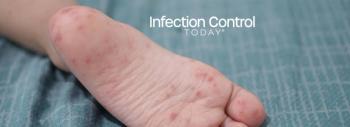
The Next Frontier in Infection Control: AI-Driven Operating Rooms
Discover how AI-powered sensors, smart surveillance, and advanced analytics are revolutionizing infection prevention in the OR. Herman DeBoard, PhD, discusses how these technologies safeguard sterile fields, reduce SSIs, and help hospitals balance operational efficiency with patient safety.
As operating rooms evolve with new demands for patient safety and efficiency, artificial intelligence (AI) is stepping in as a transformative force, particularly when it comes to infection prevention and reducing surgical site infections (SSIs). From smart surveillance systems that guard sterile fields to AI-driven environmental monitoring that catches risks invisible to the human eye, hospitals are exploring advanced technologies that protect patients and streamline workflows at the same time.
In this interview, Infection Control Today® (ICT®) speaks with Herman DeBoard, PhD, CEO and Founder of Huvr Inc, to explore how AI-powered sensors, smart devices, and predictive analytics are reshaping the modern operating room (OR). The conversation examines into how these innovations monitor hand hygiene, traffic flow, air quality, and instrument handling, all of which are critical factors in preventing SSIs, while also tackling challenges like data integration, alert fatigue, and staff buy-in. Looking ahead, DeBoard shares a vision of AI-enabled operating rooms where operational speed and infection prevention excellence are not competing priorities, but complementary outcomes driven by intelligent systems.
ICT: How can AI-driven sensors and smart surveillance systems help ensure that sterile fields remain uncompromised, and what role might they play in proactively preventing SSIs?
Herman DeBoard, PhD: AI-driven sensors and smart surveillance systems are transforming the way hospitals protect sterile fields and reduce the risk of surgical site infections (SSIs). These systems go beyond traditional monitoring by using computer vision and contextual AI to detect behaviors, movement patterns, and environmental conditions in real time. In sterile environments like operating rooms, even small breaches—such as improper gowning, unauthorized entry, or the introduction of non-sterile objects—can compromise the surgical field. AI can continuously monitor for these micro-events with precision that human observers often miss.
For example, Airez—[Huvr Inc] AI-powered physical intelligence platform—uses visual and environmental sensors to recognize when a sterile zone is unintentionally crossed or when staff behavior deviates from standard protocols. The system can immediately alert surgical teams or infection control officers, allowing for rapid corrective action before contamination occurs.
Additionally, AI can monitor hand hygiene [adherence], traffic in and out of the OR, and environmental factors like temperature, humidity, and air quality—all of which are known contributors to SSIs. By correlating this data over time, hospitals can identify risk patterns and make proactive policy changes to improve outcomes.
ICT: In what ways could real-time monitoring of OR traffic and door openings using AI-enabled physical security systems reduce known risk factors for airborne contamination and SSIs?
HB: Real-time monitoring of OR traffic and door openings with AI-enabled physical security systems can significantly reduce airborne contamination risks, which is a key factor in surgical site infections (SSIs).
Each time an operating room door opens, it disrupts the pressurized airflow that’s designed to keep contaminants out. Repeated or unnecessary entries increase the likelihood of airborne particles carried by people, equipment, or airflow from entering the sterile environment. AI steps in as a powerful, always-on monitoring layer that doesn't just track entries, it understands the context of movement.
Using sensors and AI-driven analytics, the system can detect patterns like excessive door openings, unauthorized access, or unusual traffic during critical moments in a procedure. This data is immediately actionable. Teams can be alerted in real time, and the system can also generate reports that show trends and deviations over time.
By turning raw motion data into context-aware insight, AI empowers infection control teams to correct behavior, reinforce protocols, and fine-tune scheduling or workflows. In the long run, it helps facilities quantify the invisible, making airborne contamination risks visible, traceable, and ultimately reducible.
This is how AI transforms environmental monitoring from passive observation into a proactive layer of defense for surgical integrity.
ICT: How are smart devices and asset tracking technologies improving instrument handling and traceability, and what implications does this have for reducing breaches that could lead to infections?
HB: Smart devices and asset tracking technologies are revolutionizing instrument handling by bringing unprecedented visibility, accountability, and automation to the surgical workflow, significantly reducing the risk of breaches that lead to infection.
Traditionally, surgical instruments have been tracked using manual processes, including paper logs, barcode scans, or siloed systems prone to human error. Smart sensors and RFID-enabled devices now enable real-time location tracking, usage monitoring, and automated logging of every instrument’s journey from sterilization, to prep, to procedure, and back to reprocessing.
AI-powered systems can flag inconsistencies, such as a missing sterilization step, an instrument used beyond its validated cycle count, or tools being opened too early or in the wrong sequence. This level of oversight helps ensure compliance with sterilization protocols and prevents accidental use of compromised instruments.
The implications for infection prevention are profound. Breaches in handling that previously went unnoticed can now be caught instantly. Plus, in the event of an infection or adverse outcome, detailed traceability provides a clear audit trail for root cause analysis and process improvement.
Ultimately, smart tracking transforms surgical environments from reactive to proactive, reducing human error, enhancing safety, and reinforcing trust in the sterile field.
ICT: What challenges do you foresee in integrating AI-based environmental monitoring (such as temperature, humidity, or particulate counts) directly with infection prevention protocols in the OR?
HB: The integration of AI-based environmental monitoring into infection prevention protocols holds incredible promise, but it’s not without challenges.
First, data interoperability is a major hurdle. Many hospitals still use siloed systems for HVAC, building management, and infection control. Getting AI systems to ingest data from disparate platforms—especially legacy infrastructure—can require significant customization or upgrades to achieve real-time responsiveness.
Second, there’s the issue of alert fatigue. Environmental shifts like temperature or humidity changes happen frequently, and not every fluctuation requires intervention. The key challenge is teaching AI to recognize which changes are clinically relevant. Without smart contextual filtering, staff may ignore alerts, undermining the system’s purpose.
Third, validation and regulatory compliance in clinical settings are stringent. Infection prevention protocols are rooted in evidence-based standards, so any AI-based system must prove not only its technical accuracy but also its clinical value. That means rigorous testing, validation studies, and often, lengthy approval cycles.
Lastly, change management and staff training can’t be overlooked. Successfully deploying AI monitoring tools requires cultural buy-in—from infection control teams to surgical staff to facilities managers. If the system isn’t trusted or fully understood, it won’t be used effectively.
Despite these challenges, the long-term upside is clear: AI can transform environmental monitoring from a passive, report-driven task into a real-time, predictive layer of protection that supports higher standards of infection control in the OR.
ICT: Looking ahead, how do you envision AI-enabled ORs balancing operational efficiency with stringent infection prevention goals, especially when it comes to protecting patients from SSIs?
HB: AI-enabled ORs represent a powerful convergence of precision, efficiency, and safety, where operational excellence and infection prevention no longer have to compete, but instead, complement one another.
Looking ahead, AI will serve as the invisible backbone of the modern OR, constantly analyzing data from sensors, cameras, access controls, and environmental systems to maintain a state of proactive readiness. Every door opening, equipment handoff, and personnel movement will be monitored not for punishment, but for pattern optimization and real-time risk mitigation.
AI will allow hospitals to model and automate workflows that prioritize both efficiency and sterile integrity. For instance, predictive analytics could stagger room entries to reduce unnecessary foot traffic or automatically trigger room air exchange protocols when thresholds are crossed. Smart systems could flag repeated breaks in protocol before they escalate into widespread risk, enabling real-time course correction.
Most importantly, AI will liberate human staff from tedious oversight duties, allowing them to focus on clinical care. By turning real-time operational data into actionable intelligence, AI becomes a force multiplier, helping the OR team stay compliant, informed, and focused on the patient.
In the future, AI won’t just help hospitals meet infection control standards—it will help redefine them, raising the bar for safety while accelerating care delivery. It’s not about choosing between speed and safety; it’s about using intelligence to elevate both.
Newsletter
Stay prepared and protected with Infection Control Today's newsletter, delivering essential updates, best practices, and expert insights for infection preventionists.






